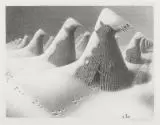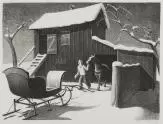Why Do We Collect?
This article has been re-published – its original publish date was September 5th, 2016. Story has been edited to include a new cover photo.

In the end, someone recently told me, all we really have are our memories.
In the meantime, I decided, after giving this some thought, many of us collect objects that help us preserve those cherished memories.
And we are fortunate to have, both past and present, artists who have the skills to capture in various media images that remind and refresh those specific memories we each hope to carry with us to the end.
My collecting has always reflected my relationship to my extended family and my years growing up in a small town in Illinois. My first collection of Lincoln pennies started at my grandmother’s kitchen table, where we began filling a blue Whitman coin folder with worn pennies poured out of mason jars she had been filling for decades.
In addition to those tattered coin folders, I still have my first piece of Arts and Crafts furniture, a modest dropfront desk my father used to start his business after he returned from his service in the Navy during World War II.
I have collected many of the nineteen lithographs which Iowa’s native son Grant Wood (1891-1942) created during the final five years of his life. Each captured an aspect of rural or small town life during the first half of the twentieth century: school children celebrating Arbor Day, a farmer carrying a bushel basket of ear corn, another digging fence post holes, a group of enthusiastic Shriner’s at their monthly meeting, and a family doctor making a house call at three in the morning.

Grant Wood began his career as an Arts and Crafts metalsmith. In 1910 he studied design under Ernest Batchelder, one of the most influential teachers of the Arts and Crafts movement. Wood then lived for a few years in Chicago, where he worked as a silversmith at Kalo before starting his own short-lived silver shop named the Volund Shop (1914-1915).
While we tend to associate the art of the Arts and Crafts movement with prints made from carved blocks of wood, Grant Wood picked up an artist’s brush rather than a carver’s chisel and applied his skills to a blank canvas rather than a block of wood. For nearly a dozen years he painted scores of undistinguished impressionistic scenes of French and Iowa landscapes before turning his attention to portraiture and the instantly-famous 1930 American Gothic. For the next seven years he struggled to convince critics that he was more than a one-hit wonder, before then nearly turning his back on oil painting and taking up lithography – drawing with wax pencils on a 9” x 12” slab of polished limestone before handing it over to printer George Miller, who then pulled 260 prints from each stone before scrubbing it clean.
In the end, Grant Wood captured on those 9” x 12” sheets of paper, each bearing his penciled signature at the bottom, memories of Midwestern life, of times and traditions he accurately believed were nearing extinction: horse-drawn wagons soon to be replaced by mechanical pickers, whirling windmills by electric well pumps, and shocks of wheat stalks by twine encrusted bales.
Often scorned by depression-era critics who called his lithographs “farmland fantasies,” Grant Wood remained determined to capture on paper his memories of a rural childhood, enabling us to stand before them and appreciate as well a time in life that has since nearly disappeared.
Except for our memories.

Until next Monday,
What’s in your collection?
Bruce
PS – If you are interested, you can read my book “Grant Wood: The 19 Lithographs,” at www.GrantWoodPrints.com.
Cover Photo: Fertility
Top: December Afternoon
Middle: January
